By Ernie Tretkoff
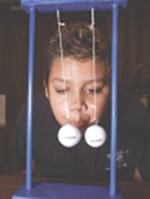 Bernoulli's principle in action at the Purdue Physics on the Road show. |
Twenty traveling physics demonstration troupes have been on the road all across the country this year, using grants from the APS Physics on the Road program, part of the celebration of the World Year of Physics. These shows are reaching schools and community groups in many areas, including poor, inner city, and rural areas where children would not otherwise have had the opportunity to see such a show.
Students of all ages watched these exciting and sometimes explosive shows. They touched liquid nitrogen clouds, made their hair stand up on end with a Van de Graaff generator, and marveled at bed of nails demonstrations, spinning bicycle wheel gyroscopes, and many other demonstrations, all while learning about physics.
As reported in APS News in February, the 20 Physics on the Road grant recipients were chosen from among forty applicants. Each group received $10,000 for supplies, vehicle maintenance, room and board for participants, and other costs associated with performing physics demonstrations. Funding was provided by the National Science Foundation, the Department of Energy’s Office of Science, and the National Institute of Standards and Technology.
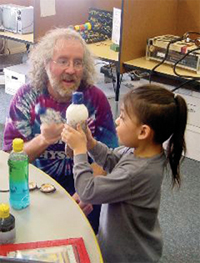 Bernoulli's principle in action Brian Jones of Colorado State U. and friend at the southern Navajo reservation. |
“The shows are great because they really show kids the fun and exciting side of physics,” said Jessica Clark, APS Public Outreach Coordinator. “It has also been rewarding for us at APS to be able to help these programs.” The Physics on the Road grants also give some visibility to these groups, which reach thousands of young people but often receive little recognition.
Some teams have used the grants to travel farther or do more shows, some have expanded their shows and created more demonstrations, and some have worked to make demos that incorporate topics recommended or required by state or national science standards.
The University of Texas at Brownsville and Texas Southmost College Physics Circus traveled around the Rio Grande area, reaching thousands of middle school students with their show, called Si! Tu Puedes ser un Cientfico! (Yes! You can be a scientist!) They report having surveyed students before and after the presentations. Before the show, when students were asked “what is physics?” most answered “I don’t know.” After the show, the students had an understanding of physics as a branch of science that relates to motion, or at least replied that “I don’t know, but it looks cool and fun to me.” Other Physics on the Road groups report similar increases in student’s interest in physics after students attended a demonstration.
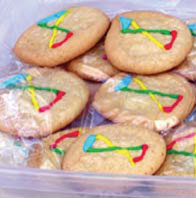 WYP Cookies baked by Grace Johns at Illinois State University. |
The Carolina Physics on the Road group (whose motto is “CPR gets your heart pumping”) from the University of North Carolina, Chapel Hill, has used the grant to expand and formalize its program, especially developing collaborations with other outreach groups on campus, including a traveling lab from the biology department, and the UNC’s Morehead Planetarium, where the Physics on the Road team plans to do as many as a dozen shows a week this fall. While it’s not truly “on the road,” these shows have a big impact because so many student groups visit the planetarium, said Duane Deardorff, who is in charge of the UNC Physics on the Road program. Some of the CPR group's demos are quite unusual. With younger children, Deardorff likes to do a simple demonstration of density that always amazes people–it turns out that a 10 pound bowling ball will float, but a 14 pound one will sink. He also likes to have students play with “roomerangs,” small boomerangs that can be thrown in a room like a school cafeteria. “It’s a really fun toy, but there’s also lots of fun physics that can be demonstrated,” he says. Deardorff is also trying to make portable versions of some of his demonstrations, including a water drop and strobe light setup that makes falling water drops appear suspended in air. “We’re using Physics on the Road grant funds to make this into something we can take on the road,” he said.
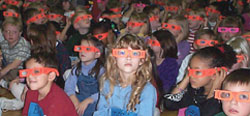 Students watch the Frontier Physics road show put on by Northern Illinois U. |
The University of Oregon has incorporated a professional circus performer into its show, using juggling and other circus arts to demonstrate concepts such as gravity and rotational motion. As a side effect, the Physics on the Road grant has made the World Year of Physics more visible to their own department, the Oregon group reports.
The University of Wisconsin, Madison group is taking the “on the road” part quite seriously–they’re well on their way to meeting their goal of visiting every one of the 42 counties in the state with their show, which includes favorites such as a liquid nitrogen cloud, exploding balloon, bowling ball pendulum and many others.
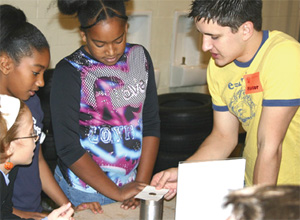 Students at Jonas C. Salk elementary school do hands-on physics at the Purdue demo show. |
The University of Iowa group has also expanded its reach, traveling as far as 110 miles from Iowa City. They have already visited three times as many locations as last year. During the summer they reached many minority and disadvantaged students who were participating in science camps. The group also expects to use the Physics on the Road grant as a springboard to get other grants.
Perhaps the largest area served has been by the Idaho State University physics demo road show, which has traveled to Utah, northern Nevada, eastern Oregon, and southern Idaho, and plans to visit schools and community groups in Montana, Wyoming, and northern Idaho later this year.
©1995 - 2024, AMERICAN PHYSICAL SOCIETY
APS encourages the redistribution of the materials included in this newspaper provided that attribution to the source is noted and the materials are not truncated or changed.
Associate Editor: Jennifer Ouellette
Staff Writer: Ernie Tretkoff
October 2005 (Volume 14, Number 9)
Articles in this Issue

